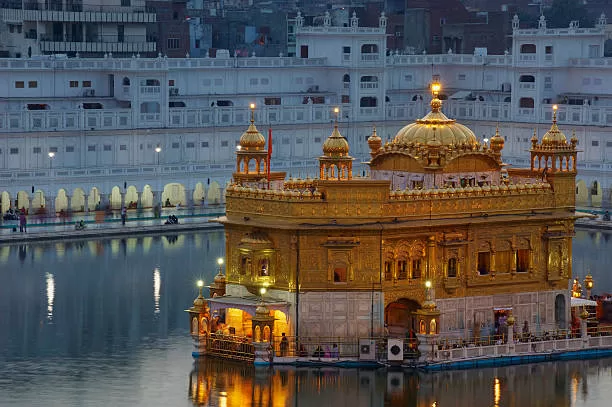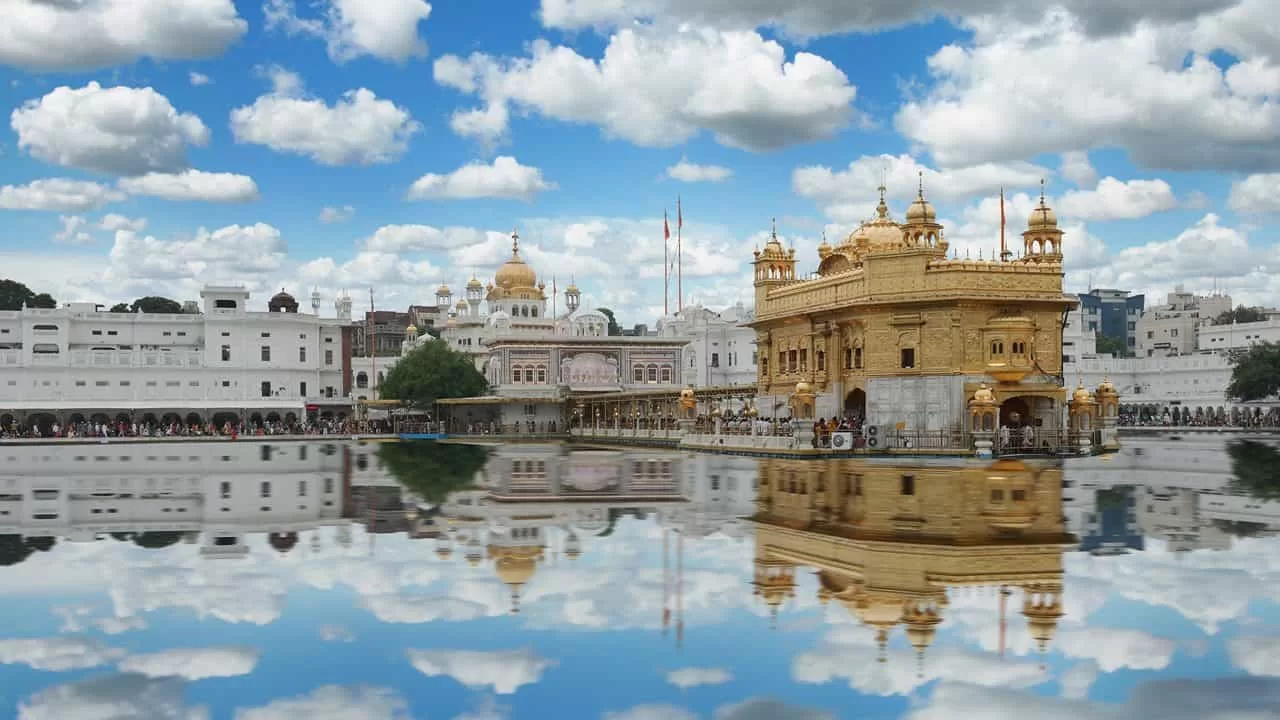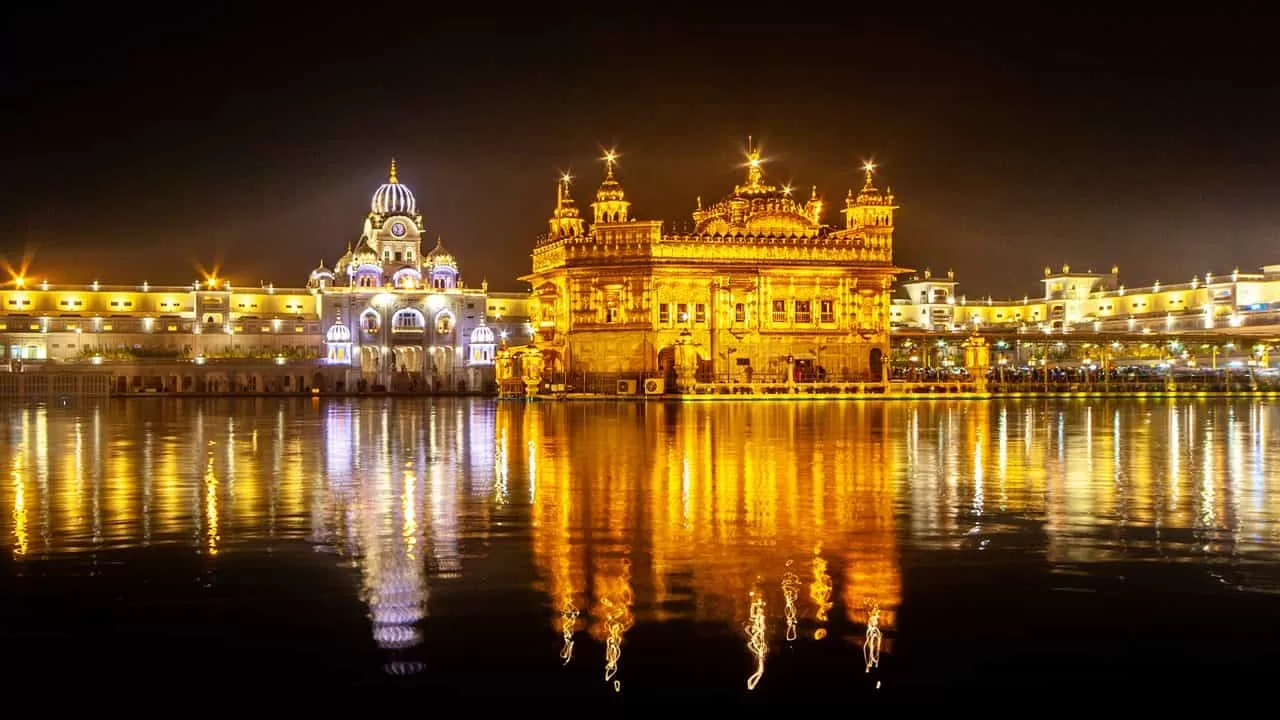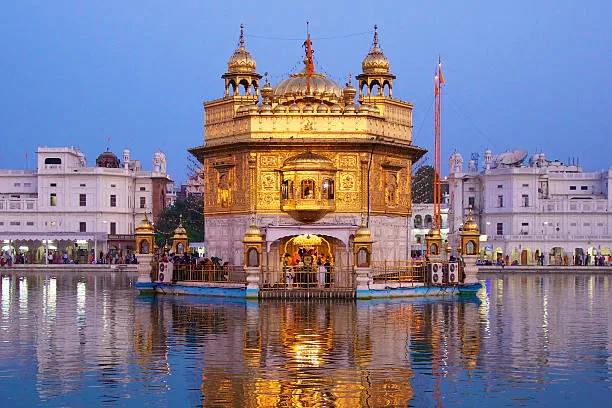Golden Temple, Nestled in the heart of Amritsar, Punjab, the Golden Temple stands as a beacon of spirituality, unity, and service. Floating like a shimmering mirage of gold on the tranquil waters of the Amrit Sarovar, the temple is not only a place of worship but also a symbol of Sikh values such as equality, service, and community. The temple derives its name from the astonishing 400 kilograms of pure gold leaf adorning its majestic dome.
As one approaches the gurdwara, also known as Harmandir Sahib, the sight of its golden dome shimmering in the sunlight is captivating, drawing visitors closer to its sacred embrace. The name “Shri Harmandir Sahib” is deeply rooted in Sikh tradition, with ‘Harmandir’ derived from ‘Hari,’ signifying God, and ‘mandir,’ meaning temple. The addition of ‘Sahib’ denotes reverence and respect within the Sikh faith.
ALSO READ: Red Fort: A Timeless Symbol of India’s Glorious Past
The history of the Golden Temple whispers through its marble walls, narrating tales of devotion and resilience. The temple was founded by Guru Ramdas Sahib, the fourth of the ten Sikh Gurus. However, the construction of the temple and its surrounding pool was continued by Guru Arjan Dev, the fifth Sikh Guru, in 1588.

A Testament to Faith, Inclusivity, and Grandeur
Centuries of faith, turmoil, and triumph have shaped the temple. Its intricate architecture, a fusion of Islamic and Hindu styles, reflects the inclusive ethos of Sikhism, inviting people from all religions to seek solace. Over the years, the temple has undergone numerous renovations, with features such as marble inlays adorning the floor. Maharaja Ranjit Singh, the founder of the Sikh Empire of India (1799-1849), covered the temple’s upper floors with 750 kilograms of pure gold.
With its golden dome, exquisite architecture, and serene surroundings, the Golden Temple attracts millions of visitors worldwide each year, making it one of the most visited religious sites in the world. Beyond its stunning beauty, the Golden Temple stands as a profound symbol of Sikh philosophy, which emphasizes the equality of all people, regardless of caste, creed, or gender. Sikhs around the world include in their daily Ardas a heartfelt wish to pay obeisance at Sri Harmandir Sahib (Golden Temple).
Experiencing the Golden Temple
A single visit to the Golden Temple never feels enough to truly embrace its profound essence, but you can certainly try. To witness the temple in its full glory, consider planning your visit during major festivals such as Baisakhi and Diwali. These vibrant celebrations showcase the temple at its most lively and spiritual.
A Sacred Haven of Spirituality and Architecture
Entering through the ornate gates of the Golden Temple is a mesmerizing experience. The interiors are adorned with intricate frescos and floral motifs, while verses from the Sikh scripture, etched in gold lettering, grace the arches. A sense of reverence envelops visitors as they gaze upon the Amrit Sarovar (Pool of Nectar), the sacred tank surrounding the temple. The waters of the Sarovar are believed to possess healing properties, encouraging pilgrims to cleanse their souls and renew their spirits.

The shimmering reflection of the gold-encrusted dome in the crystal-clear waters of the Amrit Sarovar creates a breathtaking view, especially when entering through the impressive northern gate. Walking along the marble pathway encircling the pool allows visitors to absorb the serene ambiance. Devotional music, bathing pilgrims, golden carp, and meditating devotees contribute to the sacred atmosphere, making every moment spent here truly unforgettable.
The Golden Temple: A Sacred Haven
The Golden Temple complex comprises various structures surrounding the main sanctum and the adjacent water body. Among these, the Akal Takht holds prominence as one of the five seats of power in Sikhism. Other notable features include a museum, a clock tower, and the heartwarming community kitchen, or Langar, which completes the ensemble of this sacred haven.
Festivals and Celebrations
The temple comes alive during festivals such as Vaisakhi, Guru Nanak’s birthday, Guru Teg Bahadur’s martyrdom day. And Guru Ram Das’s birthday. During Diwali, the Golden Temple is illuminated with thousands of earthen lamps (diyas). Creating a spectacular display of light and devotion.
Where Tranquillity Meets Grandeur
Inside the temple, the Guru Granth Sahib. The Darbar Sahib, the central worship hall, enshrines the eternal Guru of Sikhism. Hymns and prayers echo through the halls, reverberating the timeless teachings of the Gurus.

To avoid long queues, visitors should visit the Darbar Sahib, where the holy book is kept. During the late afternoon or early evening. The illuminated temple complex at night is a breathtaking sight.
To conclude the visit, partake in the Langar, the community kitchen. Where the aroma of freshly cooked food invites everyone to experience the temple’s spirit of unity and service.
As you wander through the bustling corridors of the Golden Temple, you will reach the Langar. Volunteers selflessly prepare and serve free meals to all visitors in the community kitchen. This tradition embodies the Sikh principles of seva (selfless service) and equality. Offering nourishment to people from all walks of life. Visitors sit cross-legged on the floor alongside fellow pilgrims from diverse backgrounds. Visitors can savor a simple yet wholesome meal, experiencing a profound sense of unity and camaraderie.
Every Sikh gurdwara has a free kitchen, but Harmandir Sahib’s Langar is one of the largest. Serving an astonishing 100,000 vegetarian meals daily, making it a true testament to generosity and service.
A Living Testament to Sikh Values
People do not consider the Golden Temple merely a place of worship. It stands as a living testament to the core values of Sikhism – compassion, humility, and service to humanity. With its rich history, breathtaking architecture, profound religious significance, the sacred Sarovar (tank). The revered Guru Granth Sahib, and the ever-welcoming Langar, the temple leaves an indelible mark on every visitor.

Beyond the Temple
Beyond the Golden Temple, Amritsar offers much more. Whether you indulge in its sumptuous cuisine or explore the city’s many historical and cultural sites. Amritsar is a delight to discover. Notable attractions include:
- The Partition Museum – A poignant tribute to the history of India’s partition.
- Akal Takht Sahib – One of the five seats of power in Sikhism.
- Gobindgarh Fort – A historic military fort with engaging exhibitions.
For those interested in shopping, Amritsar’s bustling markets offer exquisite Phulkari fabrics. Traditional juttis (footwear), and a variety of local art and artifacts. Ensuring a fulfilling experience for every traveler.


